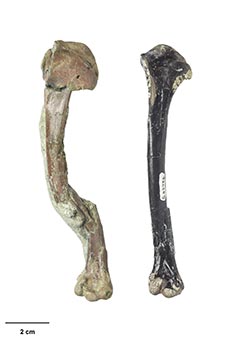

The giant duck must have been about 70 centimeters long and weighed at least 2 kilos.
For twenty years, researchers in the former gold and coal mining town of St Bathans in New Zealand have been searching for fossil remains. And that is bearing fruit. Meanwhile, several animals have been discovered that lived here millions of years ago. In a new study researchers come up with another wonderful discovery. Because in one of New Zealand’s richest fossil sites, they have found a new species of extinct duck.
giant duck
It turns out to be a particularly large specimen, as the discovery of a large wing bone shows. Named Catriona, the duck must have looked something like the paradise casarca – an endemic duck from New Zealand – but bigger. For example, the giant duck was probably about 70 centimeters long and weighed at least 2 kilos.

Catriona’s wing bone (left) compared to a wing bone from another duck found in St Bathans (right). Image: University of Otago
largest
It is not uncommon for duck remains to be found in St Bathans. In fact, duck bones are the most common bird bones found in St Bathans. We are already aware of seven duck species. But none of these were as huge as Catriona. “It’s the largest of any ducks found here,” said study researcher Alan Tennyson.
The find once again demonstrates just how rich the fauna in St Bathans once was. Several exotic species, such as relatives of flamingos and crocodiles, have already been discovered here. The ancestors of the current kiwi and bridge lizards also lived here.
Lake Manuherikia
All of these animals presumably lived together around a gigantic, prehistoric lake called Lake Manuherikia. And thanks to the discovery of more and more fossil remains, we are expanding our knowledge of the fauna of that time. “The fauna of St Bathans is about 15 to 19 million years old,” said researcher Nic Rawlence. “It opens a window to a true Miocene wonderland that we knew relatively little about until recently.”
Extinct
Unfortunately, the newly discovered giant duck did not live forever. Tennyson suspects Catriona became extinct because of dramatic tectonic and climatic changes in the area, eventually causing the entire lake to disappear. “Or maybe the duck evolved into a modern species and its descendants are still with us,” the researcher suggests.
Overall, the new discovery underscores the worldwide importance of St Bathans fossils. “We are now beginning to better understand the evolution of ducks and their relatives,” Tennyson concludes.
Source material:
†Big duck discovery” – University of Otago
Image at the top of this article: University of Otago